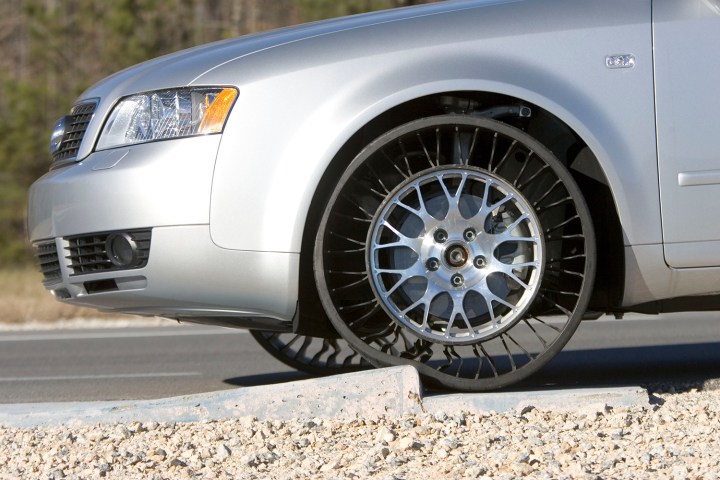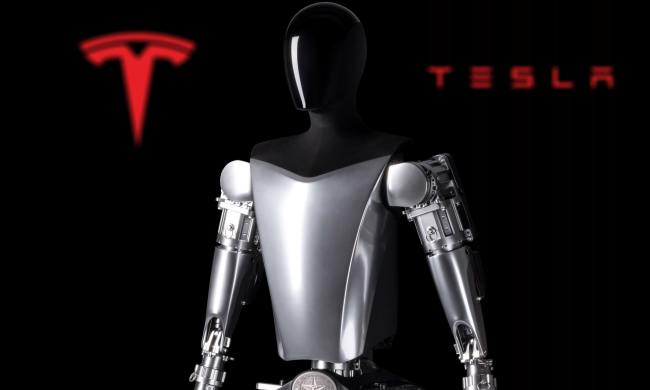
In this feature, we’ll review the latest in traditional tire technology as well as the designs and engineering principles that may well become the standard of the industry very soon. What you do with this information is entirely up to you. I might suggest using it to impress first dates, or turning the tables on that neighbor who monologues about their cat’s dieting regimen. However this knowledge gives you power, prepare yourself for innovations at all four corners of your car.
Pneumatic Tire Development
This type of tire manufacturing is how pretty much every consumer vehicle comes equipped. Early rubber tires were solid, but since John Dunlop’s first pneumatic tire was designed in 1888, the world has looked to a doughnut-shaped body of cords and wires encased in rubber and filled with compressed air. While solid rubber tires are far more durable, they’re downright uncomfortable. With well over 100 years of refinement, the pneumatic tire won’t quickly fade in the face of new technology, so we’ll start here before diving into the new/alternate construction designs.
Pneumatic tires are manufactured in approximately 455 factories around the globe producing over 1 billion products each year. It all starts with the basic ingredients: rubber, carbon black, and various chemicals. Tires are constructed on a drum and cured in a press under heat and pressure. Heat creates a polymerization reaction to link rubber monomers and create long elastic molecules. The resulting elastic components let the tire compress where rubber meets the road and then reform its original shape. With some variation, the following components make up a pneumatic tire: inner liner, body ply, sidewall, beads, apex, belt package, tread, and cushion gum.
Pneumatic tires support the rim of a wheel in a couple ways. First, tension in the cords pull on the tire bead evenly around the wheel except along the road contact section. Second, the bead transfers the pressure to the rim. Air pressure through the ply cords is applied to the bead around the wheel rim and dispersed in all directions, but if the tread is pushed in on one side, the opposing side must compensate for the added force. Radial cords were developed by Michelin in the 1940s to outperform cross-ply tire designs with reduced tire temperature, decreased rolling resistance and greater longevity.
At this point, each manufacturer uses their own compounds to deliver come combination of durability and performance, but most start with the same inputs. In case you’re curious, the highest grossing tire manufacturers include: Bridgestone, Michelin, Goodyear, Continental, and Pirelli.
What’s “Pneu” For Pneumatic Tires
Though there are discussions of all new technologies and materials, some form of pneumatic tires will continue to be produced for a long time, so let’s first review what’s around the corner for the air-filled tire.
With well over 100 years of refinement, the pneumatic tire won’t quickly fade in the face of new technology.
The greatest strides in recent years have been towards precision engineering of each tire, better rubber compounds, and data-aggregating tools built right into each tire. For example, Pirelli has been testing “digital tires” on Ferrari’s FXX K supercar to collect data about coefficient of friction, footprint, and pavement grade, which is then communicated to the car’s ECU and traction control systems to optimize power delivery based on grip. You may consider this tailor-made tech. to be unattainable, but consider how many now-common automotive technologies have started in motorsport application or purely on high-end vehicles. Pirelli is already pondering how its “cyber tires” will trickle down to road cars, and though it may take some time, personalized tires could be designed not just based on vehicle categories, but for an owner’s specific use-case to maximize durability or performance.
Speaking of durability, Michelin has made some seriously impressive developments lately. The French manufacturer has invented a tire that will evolve as it wears out, retaining its road-holding performance until the bitter end. By comparison, present tires are great when new, but as they age, they rapidly lose their grip and open space to eject water buildup – and therefore become less safe. So how’s it work? “EverGrip,” as its referred to by Michelin, uses main tread grooves that get wider as its worn down, leaving plenty of space for water to still escape. Specifically, Michelin makes its new tires with tiny slices that expand into teardrop shapes and compensate for having shallower grooves. In a sense, the tires become safer as they age. Unlike Pirelli’s digital tire tech. Michelin is already starting to integrate this technology into certain designs.
Self-inflating tires for the consumer market are also being explored. Already a technology used for heavy machinery and military vehicles, self-inflating tires use sensors that measure pressure in the tire. If the pressure is too low, an air source inflates the tire; if it’s too high, a pressure relief valve allows for deflation.
Perhaps less revolutionary than evolutionary, it’s a given that most car owners can’t effectively tell when their tires are worn out, so tires that are designed to communicate their lifespans would be useful. The “Discolor Tyre” starts life as any other black rubber tire, but as tread wear reaches minimum legal level, a layer of bright orange rubber surfaces. Sure, it’s pretty darn simple, but it could have a dramatic impact on driver safety. You and everyone around you would know when your tires are worn out – it would almost be like a badge of shame to drive on such instruments. With 13-percent of all cars on U.S. roads estimated to have one or more bald tires, this is a creative solution that will almost certainly be put into law very soon.
Breaking The Mold
Now that we’ve covered how manufacturers are moving the chains along for present tire technology, let’s look at those who want to reinvent the game.
Hankook has been experimenting with a tire design that lacks one of the elements that make current tires a royal pain: air. Punctures and leaks are a hard-to-avoid side effect of pneumatic tires, and Hankook’s airless tires want to save you the hassle. The South Korean’s manufacturer’s “iFlex” design is made entirely of eco-friendly materials and has been put through ride and handling tests in preparation for production.
It’s not just alternative energy and self-driving systems that have an tough road to mass production, even tire innovations will have their obstacles.
Since 2011, Hankook has been working on geometric shapes (in lieu of air) to offer the malleable, bouncy qualities of a standard tire. Its latest creation has been designed to fit on any wheel rim, meaning current vehicles won’t need to be retrofitted to apply iFlex tires. When tested for durability, hardness, stability, slalom, and speed, Hankook NPT (non-pneumatic tires) performed comparably to traditional air-filled tires. Not only does the new design reduce the construction process from eight stages to four, its build materials can be recycled much easier than present rubber, steel, and chemical compounds.
Cooper Tire and Rubber Company may not be trying to suck the air out of the tire industry, but its certainly getting creative with how pneumatic tires are built. The manufacturer is looking to a certain desert shrub for the key to a new synthetic rubber. The guayule plant, common in southwester deserts could become an essential component of future rubber compounds. By 2017, Cooper is planning to show a production-ready example that will reduce dependence on petroleum, something the U.S. government is pleased to hear.
You may never have heard of guayule, but its been used in natural rubber production since the early 1900s. Until now, it’s been held back from broader commercial because hevea-based rubber (the present standard) resists cracking and heat buildup better than guayule. If Cooper Tires can overcome those obstacles, the entire industry could transition for the better of the environment.
And Cooper Tires isn’t the only one looking to alternate materials for more sustainable tire construction methods. Scientists in Germany are experimenting with dandelion roots, which are far easier to harvest than rubber from rubber trees. Continental Tire might be the first manufacturer to use the roots in production tires thanks to a co-op with the Fraunhofer Institute of Molecular Biology and Applied Ecology in Germany.
Airless tires are yet another consideration. Michelin first explored the design with its “Tweel” tire back in 2005, which is made of a solid hub, flexible polyurethane spokes, and an outer band of tread. Practically, the inner spokes absorb the force from the road while driving, similar to pneumatic tires. For more variety, ‘tweels’ can be manufactured with alternate spoke tension, depending on desired handling performance. The benefits to an airless tire (besides the lack of puncture-related woes) center around their high lateral strength and resistance to hydroplaning. Moreover, Michelin claims its ‘tweels’ will last three times as long as a traditional pneumatic tire. While they still use rubber, airless tires use less of it, because you only have to throw away the tread around the spokes, not the whole wheel. This technology isn’t quite ready for general market application, however, because airless tires have greater friction patches and therefore lead to more intense vibrations at speed – something tells me the average Joe wouldn’t put up with that.
Untapped Tire Potential
It’s apparent that several innovations will have opportunities to work themselves into the traditional pneumatic tire before a wholly new form takes over. The reality is that all parts of the automotive industry move slowly, for good or bad. It’s not just alternative energy powertrains and autonomous driving systems that have an arduous road to mass production, even tire innovations will have their obstacles. But that won’t stop traditional tire manufacturers from investing R&D resources in refining air-filled tires or emerging enterprises from trying to “remake the wheel.” Advances are already here, and as long as hovering cars don’t become the norm in the next decade, we’ll at least see some of this awesome tire technology hit the pavement.



